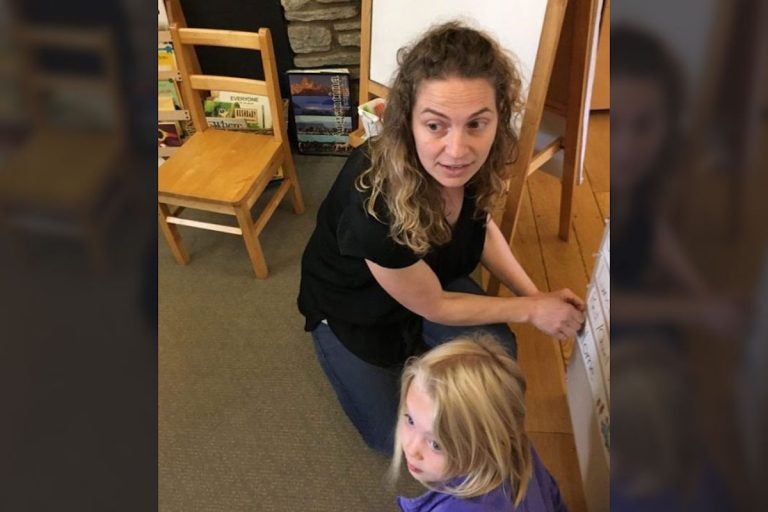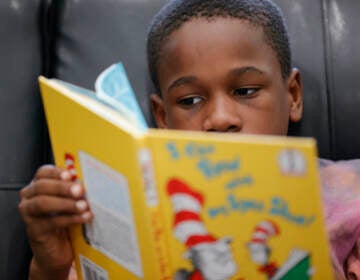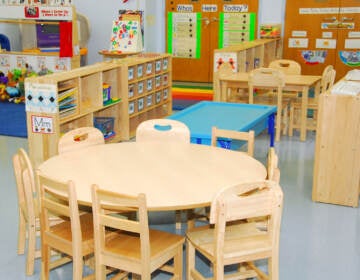Mt. Airy early childhood center works on increasing diversity
Recruitment, workshops, and "challenging" discussions about racism are all part of the effort.

Cooperative Nursery School director Leah Corsover with a student. (Paul Jablow/The Notebook)
This story originally appeared on The Philadelphia Public School Notebook.
—
It was the paint or clay on the little white girl’s hands that first drew Aquilyah Muhammad’s attention that day in 2015.
As she sat in the Allens Lane Playground in West Mount Airy while her 2½-year-old daughter, Carlisle, played nearby, Muhammad thought to herself: “The girl seems so happy. I want my kids to go someplace where they’re fully immersed in what they’re doing.”
The girl’s mother told Muhammad that her daughter was enrolled in the Cooperative Nursery School (CNS) nearby, but when Muhammad visited there, she quickly noticed that “there weren’t a lot of children of color there.” And she wanted Carlisle and her younger brother “to be around people who looked like them.”
Still, the school’s volunteer admissions coordinator was black. Muhammad enrolled Carlisle, then took that job herself, arranging open houses and distributing flyers throughout the Mount Airy and Germantown area.
Concerned about the lack of diversity at their school in a neighborhood nationally known for being integrated, the school was about to make a top-to-bottom commitment. Their approach was twofold: change the racial makeup of the school, and help parents and students deal with diversity issues.
It was a highly unusual step for a preschool, but rooted in solid ground: Research indicates that children’s attitudes toward race, ethnicity, and gender start forming well before they are ready for kindergarten.
The school’s diversity efforts have included:
- Forming a diversity committee that meets monthly.
- Stepped-up efforts to recruit students of color.
- Seminars for parents and staff on how to talk to children about diversity issues.
- Introducing more books dealing with diversity in the school’s library.
- Including a diversity feature in each issue of the school’s bi-weekly newsletter.

The school, founded in 1967, is located in a stone cottage on the wooded grounds of the Unitarian Society of Germantown. With a play area under large shade trees, it has the feel of a rural enclave in the city. The current enrollment is 39.
School leaders say the diversity effort has been aided by its cooperative structure, which leads to a more unified school community.
Families are required to help in the school at least once a month, participate in cleanup days, and do everything from setting tuition policy and fundraising to serving snacks to the children and cleaning toilets.
Silvia Diaz, CNS board chair, traces the start of the effort to the resignation of virtually the entire five-person faculty two years ago and the need to quickly hire replacements.
Faculty has remained white
There was no single reason behind the resignations, Diaz said. But when the hiring process yielded four white women for the four open positions, school leaders saw this as a troubling sign.
“We were pretty disappointed,” Diaz said in an interview. “We were trying to sort out, ‘How did we end up here?’ We wanted the school to look more like the community in which it’s situated.
“It perperetuates itself if you’ve had more white people over the years.”
Leah Corsover, the newly hired school director and lead teacher, said that although the school community had always thought of itself as valuing diversity, it “quickly saw the need for diversity efforts in admissions.”
“If our admissions were by word of mouth,” she said, “we were going to get the same body of students. We needed to push our networks out into the [neighborhood]. It was being more honest with ourselves as a community, in practice and not just in name.”

So the school started setting up information booths at area festivals and added a second open house.
It has also been seeking partnerships with nearby after-school care providers to make CNS more attractive to parents who can’t pick up their children when the school day ends.
Meanwhile, Corsover, teacher Kerry Goldman and other members of the diversity committee started setting up programming for both children and parents.
Two workshops on talking about race with young children were facilitated by Deidre Ashton, a licensed clinical social worker long active in the field.
A workshop on gender diversity was recently held for the diversity committee by Samantha King, education coordinator for the Gender & Sexuality Development Clinic at Children’s Hospital of Philadelphia.
And Maggy Williams, biracial author of the book I’m Mixed, spoke at the school, leading students in an activity exploring their own skin color.
“Some of the conversations were challenging for everybody,” said Diaz.
Parent Lindsay Edwards, who is white, said the discussions were often challenging because the children are encouraged to talk about differences that they obviously notice, not to pretend that they don’t exist, which is the case in some schools.
In her book, Williams speaks about having to decide whether to identify as white, black, or multiracial. She decided on multiracial.
In the library, the new “Family and Diversity” section includes titles like When They Ask if You’re Black or White, The Colors of Us, It’s OK to be Different, and Marvelous Me.
In Red: A Crayon’s Story, Michael Hill discusses transgender identity by using the metaphor of a blue crayon wrapped in red paper.
Goldman has also removed some books from the library, and Corsover drew up an Amazon wish list of titles she would like to add. To make the books’ lessons more real, Goldman has children mix paints showing their own skin color.
The school’s online application was reviewed last year to incorporate inclusive language and self-identification options, Corsover said. And “our marketing materials, admission policies, and mission statement were reviewed and adapted this year.”
Last year, 13 of the school’s students were non-white or mixed race. This year, 16 of the 39 students are of color.
But the mostly white faculty makeup — there has long been one black assistant teacher — remains unchanged, because there has been no turnover. That, said Diaz, “is still pretty much a work in progress.”
And changing the face of the school is just one part of the diversity effort.
“We’re trying to give the kids the values we want,” she said. “A lot of our work has been about how to talk race to our kids.”
Next: Talking race and gender to preschoolers
 The Notebook is one of 19 news organizations producing Broke in Philly, a collaborative reporting project on solutions to poverty and the city’s push toward economic justice. Read more at https://brokeinphilly.org and follow us on twitter @BrokeInPhilly.
The Notebook is one of 19 news organizations producing Broke in Philly, a collaborative reporting project on solutions to poverty and the city’s push toward economic justice. Read more at https://brokeinphilly.org and follow us on twitter @BrokeInPhilly.
WHYY is your source for fact-based, in-depth journalism and information. As a nonprofit organization, we rely on financial support from readers like you. Please give today.




